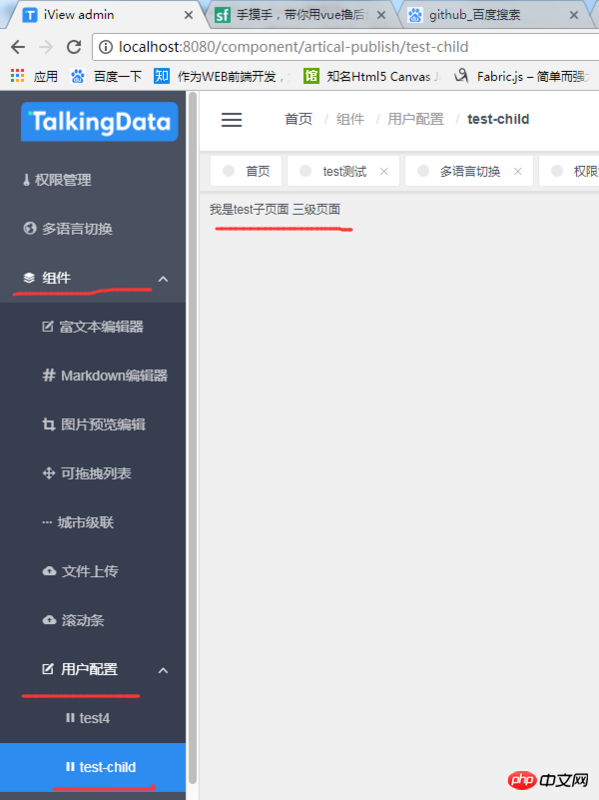這篇文章主要介紹了關於Vue iview-admin框架二級菜單改為三級菜單的方法,有著一定的參考價值,現在分享給大家,有需要的朋友可以參考一下
最近在用iview-admin的Vue後台模板,從git上下載後發現左側導航欄最多支持到二級菜單,也發現很多童鞋在問如何實現三級菜單。在實際的應用場景中還是會出現三級菜單的需求的,木有其他好方法,只能自己手動改代碼了。
1. 第一步:先改寫VUE中的模板,修改sidebarMenu.vue文件,文件具體目錄建下圖:

將Menu導航選單組件的的二級嵌套結構改為三級嵌套,無非就是判斷二級路由頁面下是否有children屬性及是否含有子元素,有的話直接v-for循環生成子元素標籤,新結構如下:
<template>
<menu>
<template>
<menuitem>
<icon></icon>
<span>{{ itemTitle(item.children[0]) }}</span>
</menuitem>
<submenu> 1" :name="item.name" :key="item.name">
<template>
<icon></icon>
<span>{{ itemTitle(item) }}</span>
</template>
<template>
<!-- 添加条件判断是否还有三级菜单 v-if="child.children.length<=1" -->
<menuitem>
<icon></icon>
<span>{{ itemTitle(child) }}</span>
</menuitem>
<!-- 以下为新增 添加条件判断如果有三级菜单 则增加三级菜单 -->
<submenu>
<template>
<icon></icon>
<span>{{ itemTitle(child) }}</span>
</template>
<template>
<menuitem>
<icon></icon>
<span>{{ itemTitle(son) }}</span>
</menuitem>
</template>
</submenu>
<!-- 以上为新增 -->
</template>
</submenu>
</template>
</menu>
</template>元件中methods下新增一個方法isThirdLeveMenu,判斷是否含有children屬性:
methods: {
changeMenu(active) {
this.$emit("on-change", active);
},
itemTitle(item) {
if (typeof item.title === "object") {
return this.$t(item.title.i18n);
} else {
return item.title;
}
},
isThirdLeveMenu(child){
if(child.children){
if(child.children.length>0)return true;
else return false;
}
else {
return false;
}
}
},第二步:修改建立目前path路徑的邏輯方法:setCurrentPath ,在libs資料夾下util.js檔案中:
util.setCurrentPath = function (vm, name) {
let title = '';
let isOtherRouter = false;
vm.$store.state.app.routers.forEach(item => {
if (item.children.length === 1) {
if (item.children[0].name === name) {
title = util.handleTitle(vm, item);
if (item.name === 'otherRouter') {
isOtherRouter = true;
}
}
} else {
item.children.forEach(child => {
if (child.name === name) {
title = util.handleTitle(vm, child);
if (item.name === 'otherRouter') {
isOtherRouter = true;
}
}
});
}
});
let currentPathArr = [];
//去首页
if (name === 'home_index') {
currentPathArr = [
{
title: util.handleTitle(vm, util.getRouterObjByName(vm.$store.state.app.routers, 'home_index')),
path: '',
name: 'home_index'
}
];
}
//去导航菜单一级页面或者OtherRouter路由中的页面
else if ((name.indexOf('_index') >= 0 || isOtherRouter) && name !== 'home_index') {
currentPathArr = [
{
title: util.handleTitle(vm, util.getRouterObjByName(vm.$store.state.app.routers, 'home_index')),
path: '/home',
name: 'home_index'
},
{
title: title,
path: '',
name: name
}
];
}
//去导航菜单二级页面或三级页面
else {
let currentPathObj = vm.$store.state.app.routers.filter(item => {
var hasMenu;
if (item.children.length {
return child.name === name;
})[0];
// let thirdLevelObj =
console.log(childObj)
//二级页面
if (childObj) {
currentPathArr = [
{
title: '首页',
path: '/home',
name: 'home_index'
},
{
title: currentPathObj.title,
path: '',
name: currentPathObj.name
},
{
title: childObj.title,
path: currentPathObj.path + '/' + childObj.path,
name: name
}
];
}
//childobj为undefined,再从三级页面中遍历
else {
let thirdObj;
let childObj = currentPathObj.children.filter((child) => {
let hasChildren;
hasChildren = child.name === name;
if (hasChildren) return hasChildren
if (child.children) {
let sonArr = child.children;
for (let n = 0; n <p><strong>第三個步驟:建立三級頁面test-child.vue,testcaca.vue和三級路由的容器組件artical-publish-center.vue</strong><br><strong>artical-publish-center.vue結構如下圖: 要有<rout-view>標籤</rout-view></strong></p><p><img src="/static/imghw/default1.png" data-src="https://img.php.cn//upload/image/524/766/974/1531115697133053.png" class="lazy" title="1531115697133053.png" alt="Vue iview-admin框架二級選單改為三級選單的方法"></p><p>##其他兩個三級頁面vue隨便寫了:</p><p><img src="/static/imghw/default1.png" data-src="https://img.php.cn//upload/image/142/703/339/1531115707261749.png" class="lazy" title="1531115707261749.png" alt="Vue iview-admin框架二級選單改為三級選單的方法"></p><p><strong>#第四步:到這裡,容器可以實現期待已久三級選單了,^_^. 在router裡新增三級頁面路由,router資料夾下router.js中:</strong><br>加到appRouter中吧,可以放到title: '元件'的children數組中: </p><pre class="brush:php;toolbar:false">{
path: 'artical-publish',
title: '用户配置',
name: 'artical-publish',
icon: 'compose',
component: () => import('@/views/test/artical-publish-center.vue'), //引用三级页面的中间容器层
children:[
{
path: 'testcaca',
icon: 'ios-pause',
name: 'testcaca',
title: 'test4',
component: () => import('@/views/test/testcaca.vue')
},
{
path: 'test-child',
icon: 'ios-pause',
name: 'test-child',
title: 'test-child',
component: () => import('@/views/test/test-child.vue')
}
]
}最後儲存,運行你的項目,看下三級選單出來了:

以上是Vue iview-admin框架二級選單改為三級選單的方法的詳細內容。更多資訊請關注PHP中文網其他相關文章!




